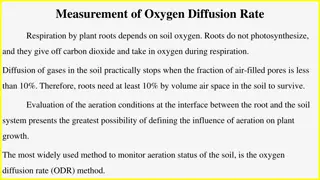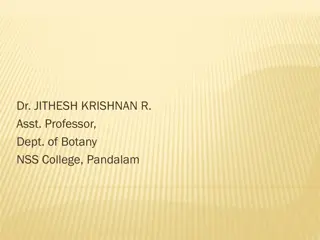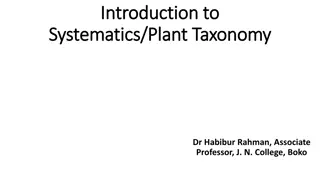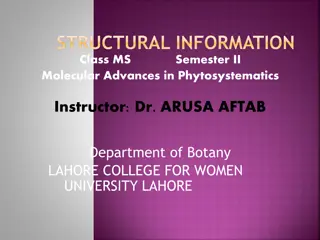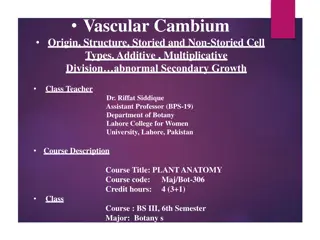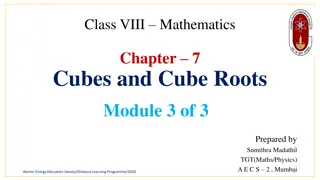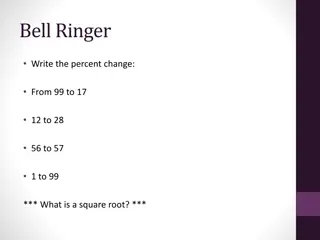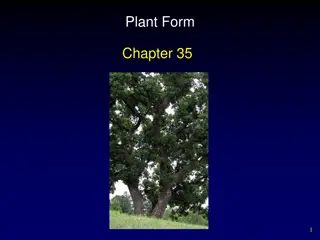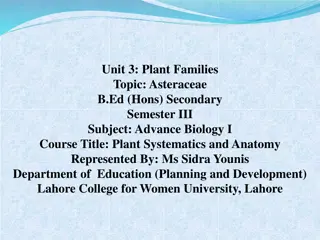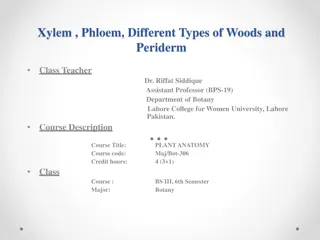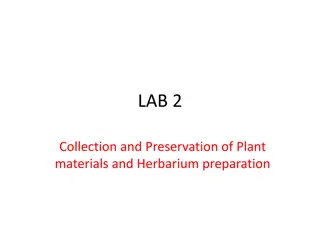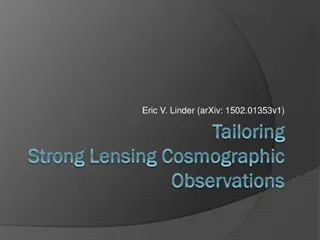Morphological Characters of Roots in Plant Systematics and Anatomy
The morphology of plant roots is essential in understanding plant systematics and anatomy. Roots are categorized into two main groups: Tap Roots and Adventitious Roots. Tap roots directly arise from the seed and can be fibrous, tuberous, conical, fusiform, or napiform. Adventitious roots develop from stems or leaves and can be underground, fibrous, tuberous, or partly subterranean with forms like stilt roots, prop roots, and aerating roots. Each type of root serves specific functions and aids in a plant's growth and survival.
Download Presentation

Please find below an Image/Link to download the presentation.
The content on the website is provided AS IS for your information and personal use only. It may not be sold, licensed, or shared on other websites without obtaining consent from the author. Download presentation by click this link. If you encounter any issues during the download, it is possible that the publisher has removed the file from their server.
E N D
Presentation Transcript
Unit 2: Morphology of Plants Topic: Root B.Ed (Hons) Secondary Semester III Subject: Advance Biology I Course Title: Plant Systematics and Anatomy Represented By: Ms Sidra Younis Department of Education (Planning and Development) Lahore College for Women University, Lahore
MORPHOLOGICAL CHARACTERS OF ROOT The cylindrical plane Organ without chlorophyll, growing towards the gravity is called root. Roots have following morphological characters Kinds Of Roots There are two groups of roots: Tap Root And Adventitious Roots. A) Tap Root The root directly arises from the seed is called tap root. The first root which is formed by the elongation of radical is called primary tap root. It gives rise to secondary and tertiary roots. The deep feeder plants have a long net work of tap root system. the surface feeder plants have short tap roots. there are following forms of tap roots: 1. Fibrous Tap Roots: The long and slender tap root with slender branches is called fibrous tap root. It is found in many herbs like bean, pea etc. In some leguminous plants, the tap roots form nodules. bacteria live in these nodules and fix atmospheric nitrogen.
CONT 2. Tuberous Tap Roots: The thick or swollen tap roots with reserve food are known as tuberous tap roots. Such roots occur in biennial plants like carrot, turnip, radish etc. The biennial plants live in two seasons. In first season (before winter) they store food in the roots. They use this food in the second season (after winter). tuberous roots may be: These roots are swollen towards tipper end but taper towards the lower end. examples: carrot, radish. Conical: These roots are swollen towards tipper end but taper towards the lower end. examples: carrot, radish. Fusiform: These tap roots are spindle shape i.e. swollen in the middle. examples: english carrot Napiform: These tap roots are very much swollen above but abruptly tapers towards the lower end. examples: turnip and beet. (b) Adventitious Roots The roots arised from the stems or sometimes leaves are called adventitious roots. it has following forms:. 1. Underground or subterranean adventitious roots: these roots arise from some part of stem which is in contact with the soil. they may be fibrous or tuberous.
CONT Fibrous Adventitious Roots: these are long and slender roots. these commonly develop on creeping and underground sterns like grasses. Tuberous Adventitious Roots: these are swollen and fleshy roots. These roots contain stored food material. examples: asparagus, sweet potato. 2. Partly Subterranean Adventitious Roots: these roots are partly above and partly below the ground. These roots may be stilt roots, prop roots and aerating roots. (a) Stilt Roots: In this case, adventitious roots arise from the lower portion of stem and grow into soil. Such types of roots are found in corn, stig: if cane, bamboo etc. (b)Prop Roots: In this case, roots hangs down in the air from the aerial branches of stern. These roots absorb moister of air. Example: bayan rubber tree etc. (c)Aerating Roots or Pneumatophores: These roots grow vertically upward and projects above the soil surface. these roots have openings the entry of air. such roots are aerial roots: these roots are entirely exposed in air. These roots perform special functions. There are two kinds of aerial roots.
CONT a. Climbing Roots: These roots are developed by stein in climbing plants. These roots firmly attach the plants with some support like wall, tree trunk. These roots secrete sticky fluid for attachment. Examples: these roots are developed in long pepper etc. b. Absorbing Roots: Some epiphytes develop long roots in air for absorption of moisture. these roots are called absorbing roots. These roots hang freely in the atmosphere. These roots are developed in orchids. 4. Parasitic Roots or Haustoria: These roots are developed in parasitic plants like cuscut stem develops these roots for absorption of food from host. These roots penetrate into the host tissues. 5. Aquatic Roots: These roots are developed in water plants. these roots arise form stem and spread in water. Example: hydrilla.
FUNCTIONS OF ROOTS Root, in botany, that part of a vascular plant normally underground. Its primary functions are anchorage of the plant, absorption of water and dissolved minerals and conduction of these to the stem, and storage of reserve foods. The root differs from the stem mainly by lacking leaf scars and buds, having a root cap, and having branches that originate from internal tissue rather than from buds. Anchoring: Roots are the reason plants remain attached to the ground. They support the plant body, ensuring that it stands erect. Absorption: Primary function of the roots is to absorb water and dissolved minerals from the soil. This is crucial as it helps in the process of photosynthesis. Storage: Plants prepare food and store in the form of starch in the leaves, shoots and roots. Prominent examples include carrots, radish, beetroot, etc.












